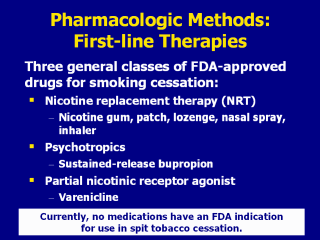| front |1 |2 |3 |4 |5 |6 |7 |8 |9 |10 |11 |12 |13 |14 |15 |16 |17 |18 |19 |20 |21 |22 |23 |24 |25 |26 |27 |28 |29 |30 |31 |32 |33 |34 |35 |36 |37 |38 |39 |40 |41 |review |
 |
There are three general classes of FDA-approved
drugs for cessation: Nicotine replacement therapy (NRT) includes the nicotine gum, patch, lozenge, nasal spray, and inhaler. A nicotine sublingual tablet currently is available in Europe. The only psychotropic agent currently approved by the FDA for smoking cessation is bupropion SR. Varenicline, a partial nicotinic receptor agonist, was approved by the FDA in 2006 for smoking cessation. According to the U.S. Public Health Service Clinical Practice Guideline for treating tobacco use and dependence, NRT and sustained-release bupropion are considered first-line pharmacotherapies for smoking cessation (Fiore et al., 2000). Varenicline, which was approved six years after the Guideline was published, is not formally classified as a first-line agent although controlled trials suggest it is equal to (Gonzales et al., 2006) or superior to (Jorenby et al., 2006) sustained-release bupropion. Currently, no medications have an FDA indication for use in spit tobacco cessation. Note to instructor(s): The following pharmacotherapies have been studied but are not recommended by the U.S. Public Health Service Clinical Practice Guideline for treating tobacco use and dependence (Fiore et al., 2000): Anxiolytic agents (buspirone, diazepam) may reduce anxiety associated with nicotine withdrawal, but these agents have not been shown to improve quit rates. Mecamylamine (Inversine) is a central/peripheral nicotinic receptor antagonist. The rationale for its use is that the blockade of the nicotine receptors will prevent the positive reinforcing and pleasurable effects of smoking. Evidence for its use as a smoking cessation aid alone is insufficient. Selective serotonin reuptake inhibitors (fluoxetine, paroxetine, sertraline), which may be used to treat withdrawal-associated depression, were not found to be effective in a meta-analysis of five trials (Hughes et al., 2004). Fiore MC, Bailey WC, Cohen SJ, et al. (2000). Treating Tobacco Use and Dependence. Clinical Practice Guideline. Rockville, MD: U.S. Department of Health and Human Services, Public Health Service. Gonzales D, Rennard SI, Nides M, et al. (2006). Varenicline, an ?4ß2 nicotinic acetylcholine receptor partial agonist, vs sustained-release bupropion and placebo for smoking cessation: a randomized controlled trial. JAMA 296:47-55. Hughes JR, Stead LF, Lancaster. (2004). Antidepressants for smoking cessation. Cochrane Database Syst Rev 4:CD000031. Jorenby DE, Hays JT, Rigotti NA, et al. (2006). Efficacy of varenicline, an α4ß2 nicotinic acetylcholine receptor partial agonist, vs placebo or sustained-release bupropion for smoking cessation: a randomized controlled trial. JAMA 296:56-63. Slide is used with permission, Rx for Change: Clinician-Assisted Tobacco Cessation. Copyright © 1999-2007 The Regents of the University of California, University of Southern California, and Western University of Health Sciences. All rights reserved. |